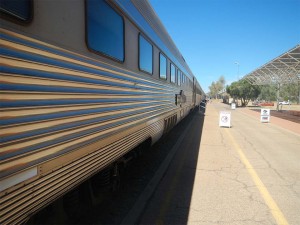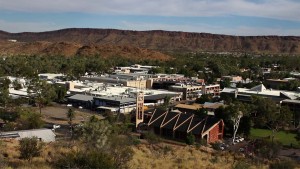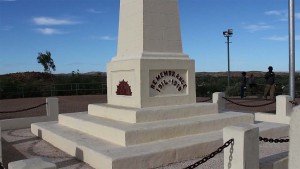Stepping onto the platform of the Alice Springs rail station, it helps to have a sense of history in order to appreciate where you’re standing. On the surface, this could be any rail platform in almost any town with a rail stop in the world. Close your eyes, as I did, in order to remove the last traces of eyesight from my already limited visual perspective, and that is in fact the first sensation… that you’re not anywhere in particular. The sounds of passengers who have been confined to a series of rail cars for several hours or days is a common experience for many world travelers – the press of clothing, the sounds of directions given by attendants to the neatest cab stand, rental car counter or the baggage car – I’ve experienced the same routine in Atlanta, Denver, San Francisco and any number of other stops… and now Alice Springs. The first impression is that to visit Alice springs is to visit, as Bill Bryson called it, “Anytown America.”
I respectfully disagree.

Even though flights to Alice springs are easy to book, and the town is often a quick pit stop on the way to Uluru, dig al title deeper. The Alice Sprigns to Uluru part of our documentary and our travels in Australia. The feel of a fresh breeze on your shoulders and on your face is a welcome relief after more than a day of recirculated air. As I had mentioned, our brief time shooting through the open window of the luggage car was a welcome luxury most passengers on the Ghan do not get. Stepping out of the cocoon of the rail car and having all the fresh air we could taken in was still a relief. Then the utter singularity of the experience… of arriving in Alice,the Australian shorthand for Alice Springs… takes over.
It does start with the air, that flat heat which, even on a windy day, feels like someone left the iron on just a few inches from your skin. The dust that is everywhere… in the air, on every surface and in every crevasse. The people around us – there were Americans, but many more Indonesians, Filipinos, Chinese… we were the only Americans as far as the eye could see, and this is fascinating the first time you experience that. We had shared our general cabin area on the route from Adelaide with two Germans who had been much more prepared than we were, having chosen to ignore GSR’s posted limits on both the size and scope of acceptable on-board baggage. One duffle bag had been filled with nothing but fruits and sandwiches, which we eyed hungrily throughout the journey. Since we had booked transit on what GSR calls Red Class, while we did have access to a dining car, we were not allowed to dine in the celebrated Queen Adelaide lounge car, and its white linen table service. Our meals were serviceable and better than we expected, but the fact of the matter is for all the incredible scenery, there’s not much to do on the Ghan but eat, sleep and lay odds on which Tony Bennett classic will show up next on the overhead speakers. You get to know your neighbors very well on a twenty five hour overland trek through the outback.
Now, here we stood on the outskirts of Alice, which is to say, not very far from the inskirts. It hits you very quickly just where you are. This platform was, for decades, the most popular hangout in this corner of the Northern Territories. It’s where supplies, food, movies… everything that made desert life not only palatable but survivable…. showed up. If it didn’t arrive by train, it didn’t arrive at all, and if you couldn’t find it in Alice, you probably weren’t finding it anywhere. Even on a warm fall afternoon in 2015, I didn’t feel very far removed from this chapter of outback history, with the Ghan’s engines cooling, the bustle of travelers around us and the 25,000 or so permanent resident of Alice easily within walking distance of where we were standing
Of course, one of the truths about Alice Springs is there are usually more impermanent residents today. Alice is all grown up and pretty savvy about the world now. As filmmakers on the road, Alice was yet another location where a professional crew can’t just set up the camera and start shooting. suppliesOur permits were safely stowed in our run bag, as they had been for Adelaide, Uluru and most other stops on our itinerary. Not only does the Stuart Highway connect Alice with the rest of the continent (although I use the word “highway” loosely. It’s paved, there are cars, but at two lanes, it’s not going to get you where you want to go in a hurry. Not necessarily a bad thing, but be warned), there’s a pretty busy airport for a town this size, with service to Sydney, Melbourne and points beyond. You can, if you choose, fly into Alice Springs for the day. Many do.
It can be easy to feel a little jilted by the lack of romance around Alice, easy to note the Hungry Jacks (Australian for Burger King), the what I have to assume is one the last surviving K-Marts in the world, and the booming satellite installation business, the first feeling you have is that Alice has given up a bit of her soul. That’s certainly how I felt as I ducked into the local Target for batteries and a bathing suit to replace the one I had lost along the way.
Of course, this is a pretty selfish attitude, and hardly fair to Alice or the people who live here. I think one of the biggest sins a traveler can commit is to act like a tourist… to demand the locals live in an historical state of suspended animation for the amusement of visitors. While one of the joys of traveling somewhere new is the fact that a place is not new, but rather “new to you,” it seems unfair to require a destination recuse itself from the pleasures of modern life so the rest of us can experience their rustic past for ourselves. Who am I, it must be asked, to demand if Alice wants a McDonalds, that Alice can’t have a McDonalds?
As always, the charm and delight of a locale new to you lies in those charms and delights found with effort, and the central idea of Alice is still very much the same. If you can’t find it in Alice, you’re not finding it. It doesn’t matter whether it’s the nineteenth century fear of running out of quinine or the twenty first century hassle of running out of saline. Yes, one is merely an inconvenience and one is life and death, but I didn’t ask to go to Alice to cheat death and frankly, neither do most people. I rather like the idea that Alice Springs has a well stocked emergency room and daily flights in and out. I think when you look at this picture of the city from an overlook not two kilometers from the rail station, you still appreciate the isolation of the place.

It is, after all, impossible to ignore the nature of the place. The Alice Springs tourist attractions (or traveler attractions as I prefer to think of them) include the Strello Aboriginal Research Center, an out of the way hangar housing the remains of an airplane owned by famed aviator George Kingston and a nature museum dedicated to showing off the varied outback environments. These are all attractions that would seem out of place in Sydney or Melbourne because these Alice Springs attractions all emphasize the otherworldly distance between Alice sprigs and everywhere else.
As we strolled through the tiny outdoor shopping area of Todd Mall, Aboriginal children were playing in the park next to us. The Australian flag hung limply near the city hall, occasionally bucked up by gusts of wind, but for the most part sagging and speckled with dust. Red Australian dust. The Australian penchant for layering everything with beets… a penchant which I do not now and will likely never understand… continued unabated. As in so many Australian towns, there was a well kept memorial dedicated to the soldiers of the first World War. There were more Australian soldiers per capita in World War One than any other country… and more casualties as well. Gallipoli is still a very big thing here.

The presence of the outback hovers like an eager understudy wherever you go. There’s a feeling the desert could emerge victorious over civilization any time it wanted to. All the fast food restaurants in the world… and they were well represented… cannot take you out of that reality.
At its heart, this is why I was here, to see nothing and be nowhere. Alice did not disappoint. Nowhere was everywhere, and the heart of it was only five hours away.
These are three books I really enjoyed while researching this portion of The Palette Project documentary and web series.
Next in the travelogue… the road to Uluru.
